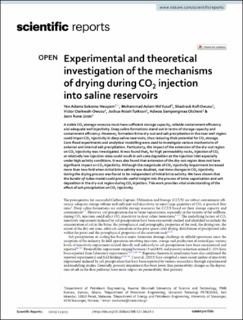| dc.contributor.author | Sokama-Neuyam, Yen Adams | |
| dc.contributor.author | Yusof, Muhammad Aslam Md | |
| dc.contributor.author | Owusu, Shadrack Kofi | |
| dc.contributor.author | Darkwah-Owusu, Victor | |
| dc.contributor.author | Turkson, Joshua Nsiah | |
| dc.contributor.author | Otchere, Adwoa Sampongmaa | |
| dc.contributor.author | Ursin, Jann Rune | |
| dc.date.accessioned | 2024-02-21T10:14:20Z | |
| dc.date.available | 2024-02-21T10:14:20Z | |
| dc.date.created | 2023-06-15T17:40:05Z | |
| dc.date.issued | 2023 | |
| dc.identifier.citation | Sokama-Neuyam, Y. A., Yusof, M. A. M., Owusu, S. K., Darkwah-Owusu, V., Turkson, J. N., Otchere, A. S., & Ursin, J. R. (2023). Experimental and theoretical investigation of the mechanisms of drying during CO2 injection into saline reservoirs. Scientific reports, 13(1), 9155. | en_US |
| dc.identifier.issn | 2045-2322 | |
| dc.identifier.uri | https://hdl.handle.net/11250/3118944 | |
| dc.description.abstract | A viable CO2 storage resource must have sufficient storage capacity, reliable containment efficiency and adequate well injectivity. Deep saline formations stand out in terms of storage capacity and containment efficiency. However, formation brine dry-out and salt precipitation in the near well region could impair CO2 injectivity in deep saline reservoirs, thus reducing their potential for CO2 storage. Core-flood experiments and analytical modelling were used to investigate various mechanisms of external and internal salt precipitation. Particularly, the impact of the extension of the dry-out region on CO2 injectivity was investigated. It was found that, for high permeability rocks, injection of CO2 at relatively low injection rates could result in salt cake deposition at the injection inlet especially under high salinity conditions. It was also found that extension of the dry-out region does not have significant impact on CO2 injectivity. Although the magnitude of CO2 injectivity impairment increased more than two-fold when initial brine salinity was doubled, real-time changes in CO2 injectivity during the drying process was found to be independent of initial brine salinity. We have shown that the bundle-of-tubes model could provide useful insight into the process of brine vaporization and salt deposition in the dry-out region during CO2 injection. This work provides vital understanding of the effect of salt precipitation on CO2 injectivity. | en_US |
| dc.language.iso | eng | en_US |
| dc.publisher | Springer Nature | en_US |
| dc.rights | Navngivelse 4.0 Internasjonal | * |
| dc.rights.uri | http://creativecommons.org/licenses/by/4.0/deed.no | * |
| dc.title | Experimental and theoretical investigation of the mechanisms of drying during CO2 injection into saline reservoirs | en_US |
| dc.type | Peer reviewed | en_US |
| dc.type | Journal article | en_US |
| dc.description.version | publishedVersion | en_US |
| dc.rights.holder | The authors | en_US |
| dc.subject.nsi | VDP::Teknologi: 500::Berg‑ og petroleumsfag: 510 | en_US |
| dc.source.volume | 13 | en_US |
| dc.source.journal | Scientific Reports | en_US |
| dc.source.issue | 1 | en_US |
| dc.identifier.doi | 10.1038/s41598-023-36419-3 | |
| dc.identifier.cristin | 2155041 | |
| cristin.ispublished | true | |
| cristin.fulltext | original | |
| cristin.qualitycode | 1 | |

